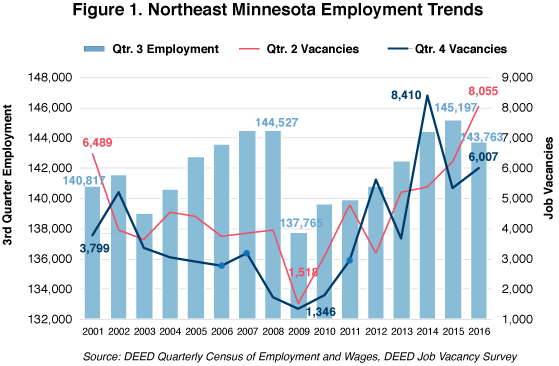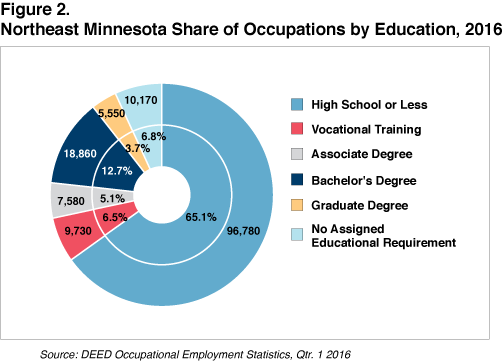
by Cameron Macht
June 2017
Fifty-six percent of the region’s job openings last year were for part-time positions.
After finally regaining all the jobs lost during the Great Recession, Northeast Minnesota took a step back last year. Employment in the region fell below 2008 levels, with employers reporting fewer than 144,000 jobs in the third quarter of 2016. That was about 750 fewer jobs than in the third quarter of 2008 and about 1,400 fewer jobs than in 2015.
Nonetheless, hiring demand in the region remains high. Local businesses have reported steadily increasing vacancies over the past three years, averaging more than 6,000 openings each quarter and hitting a record peak of 8,410 vacancies in the fourth quarter of 2014 and 8,055 vacancies last summer (see Figure 1).

Despite rising demand, the median wage offer across all job vacancies in Northeast Minnesota fell to $12.47 in the fourth quarter of 2016. That was the second-lowest among the state’s six regions. Wages had been increasing, but the recent drop was due to a shift in the type of vacancies posted.
The share of openings that were part time jumped from 36 percent in 2015 to 56 percent in 2016, while the share of vacancies that required postsecondary education dropped from 43 percent to 33 percent. Employers placed the same premium on prior work experience, with about one-third of openings requiring at least one year of experience in both 2015 and 2016.
There was also a noticeable drop in the percentage of vacancies that provided health care benefits. Just 41 percent offered health care in the fourth quarter of 2016, compared with 59 percent of openings in the fourth quarter of 2015.
Three industries offered health care benefits for almost all of their openings: mining, information, and finance and insurance. Combined, however, they accounted for only 155 of the region’s total vacancies. Public administration and manufacturing both offered health care benefits in about 80 percent of their job postings, but they also had relatively few vacancies.
In contrast, the health care and social assistance, retail trade, and accommodation and food services industries provided over two-thirds of the region’s hiring demand in 2016. But only about one-third of the jobs posted in these industries offered health care benefits, and over 60 percent of the openings were part time. Ninety-five percent of the job postings in administrative support and waste management services, including temporary staffing agencies, were part time, and only 3 percent offered health care benefits.
Job seekers looking for higher compensation will want to focus on industries that offer higher wages and health care benefits. The industries listed above, as well as professional and technical services, other services, health care and social assistance, and transportation and warehousing, might have an easier time attracting candidates because of the combination of better wages and benefits (see Table 1).
| Northeast Minnesota Job Vacancy Survey Results, Qtr. 4 2016 | |||||
|---|---|---|---|---|---|
| Industry | Number of Job Vacancies | Percent Part-Time | Requiring Post-Secondary Education | Median Wage Offer | Health Care Benefits |
| Total, All Industries | 6,007 | 56% | 33% | $12.47 | 41% |
| Health Care and Social Assistance | 2,155 | 62% | 46% | $13.24 | 40% |
| Retail Trade | 1,536 | 60% | 7% | $10.69 | 38% |
| Accommodation and Food Services | 436 | 60% | 2% | $10.58 | 18% |
| Educational Services | 366 | 68% | 52% | $13.88 | 34% |
| Other Services | 337 | 18% | 60% | $14.39 | 54% |
| Admin. Support and Waste Mgmt. Services | 229 | 95% | 53% | $13.60 | 3% |
| Arts, Entertainment and Recreation | 206 | 46% | 3% | $10.31 | 39% |
| Public Administration | 181 | 49% | 37% | $14.46 | 81% |
| Transportation and Warehousing | 167 | 53% | 50% | $16.88 | 50% |
| Manufacturing | 142 | 2% | 39% | $14.89 | 78% |
| Finance and Insurance | 103 | 3% | 52% | $22.27 | 97% |
| Professional and Technical Services | 41 | 0% | 86% | $21.49 | 71% |
| Mining | 38 | 0% | 87% | $18.59 | 100% |
| Real Estate and Rental and Leasing | 18 | 34% | 4% | $13.09 | 17% |
| Information | 14 | 0% | 0% | $16.21 | 100% |
| Utilities | 13 | N/A | N/A | $31.75 | N/A |
| Source: DEED Job Vacancy Survey | |||||
Of existing jobs in the region, two-thirds do not require any education past high school (see Figure 2). In fact, 20 of the 25 largest occupations in the region can be gained with a high school education.

Many of these low-skill occupations – retail salespeople, personal and home care aides, cashiers, and food prep and serving workers – pay relatively low wages, compared with higher wages offered to higher-skill occupations that do require postsecondary training, such as registered nurses, general and operations managers, school teachers and licensed practical nurses.
Despite low wages in some of the largest occupations, workers in more than 135 occupations requiring a high school diploma or less were earning median wages above $35,000 per year in Northeast Minnesota, including heavy and tractor-trailer truck drivers, secretaries, office managers, carpenters, construction equipment operators and sales representatives. This represents nearly 24,000 jobs in Northeast Minnesota (see Table 2).
| Top 20 Occupations Requiring High School or Less Earning Over $35,000 in Northeast Minnesota | ||||
|---|---|---|---|---|
| Occupational Title | Estimated Regional Employment | Median Annual Wage | Projected Job Growth 2014-2024 | Total Openings 2014-2024 |
| Truck Drivers, Heavy and Tractor-Trailer | 2,060 | $38,251 | -1.5% | 370 |
| Secretaries and Admin. Assistants | 1,510 | $36,035 | -3.4% | 180 |
| First-Line Supervisors of Office and Admin. Workers | 1,000 | $51,162 | 1.5% | 170 |
| Carpenters | 950 | $47,139 | 0.9% | 160 |
| Construction Equipment Operators | 930 | $59,785 | 1.2% | 200 |
| Sales Representatives, Wholesale and Manufacturing | 870 | $51,794 | 0.4% | 190 |
| Construction Laborers | 870 | $43,284 | 3.8% | 260 |
| Medical Secretaries | 700 | $35,676 | 5.2% | 100 |
| Truck Drivers, Light or Delivery Services | 690 | $36,315 | -0.6% | 130 |
| First-Line Supervisors of Production Workers | 530 | $56,678 | -2.9% | 90 |
| Welders, Cutters, Solderers and Brazers | 520 | $42,365 | 3.4% | 220 |
| Executive Secretaries and Admin. Assistants | 470 | $44,638 | -4.1% | 60 |
| First-Line Supervisors of Mechanics and Installers | 430 | $62,336 | -2.0% | 90 |
| Highway Maintenance Workers | 390 | $48,254 | -1.2% | 100 |
| Postal Service Mail Carriers | 380 | $57,190 | -32.7% | 70 |
| Plumbers, Pipefitters and Steamfitters | 380 | $63,836 | 0.2% | 50 |
| Industrial Truck and Tractor Operators | 360 | $38,527 | -8.4% | 100 |
| Correctional Officers and Jailers | 340 | $47,332 | -3.1% | 80 |
| First-Line Supervisors of Construction Workers | 340 | $70,746 | 0.2% | 30 |
| Furnace, Kiln, Oven, Drier and Kettle Operators | 320 | $44,526 | N/A | N/A |
| Total, All Occupations | 142,870 | $34,561 | 2.0% | 44,660 |
| Source: DEED Occupational Employment Statistics, 2014-2024 Employment Outlook | ||||
Likewise, more than 6,000 jobs requiring vocational training paid more than $35,000 per year at the median, showing that there are high-paying jobs found in every educational category.
Though jobs requiring a high school diploma or less are expected to account for about two-thirds of total employment in the region by 2024, they are projected to be the slowest-growing group of jobs by education level, according to DEED's Employment Outlook tool. Those jobs are projected to grow 1.2 percent from 2014 to 2024, but they will account for over 40 percent of the new jobs created in the region.
The fastest growth is projected for jobs requiring vocational training or associate degrees, which are both expected to expand by more than 5 percent and account for about 30 percent of new job growth. Jobs requiring bachelor's and advanced degrees were projected to grow 2.5 and 3.8 percent, respectively.
With a tightening labor market, employers will likely continue to struggle to fill job vacancies. Job seekers, meanwhile, will find a variety of opportunities at every education and wage level.